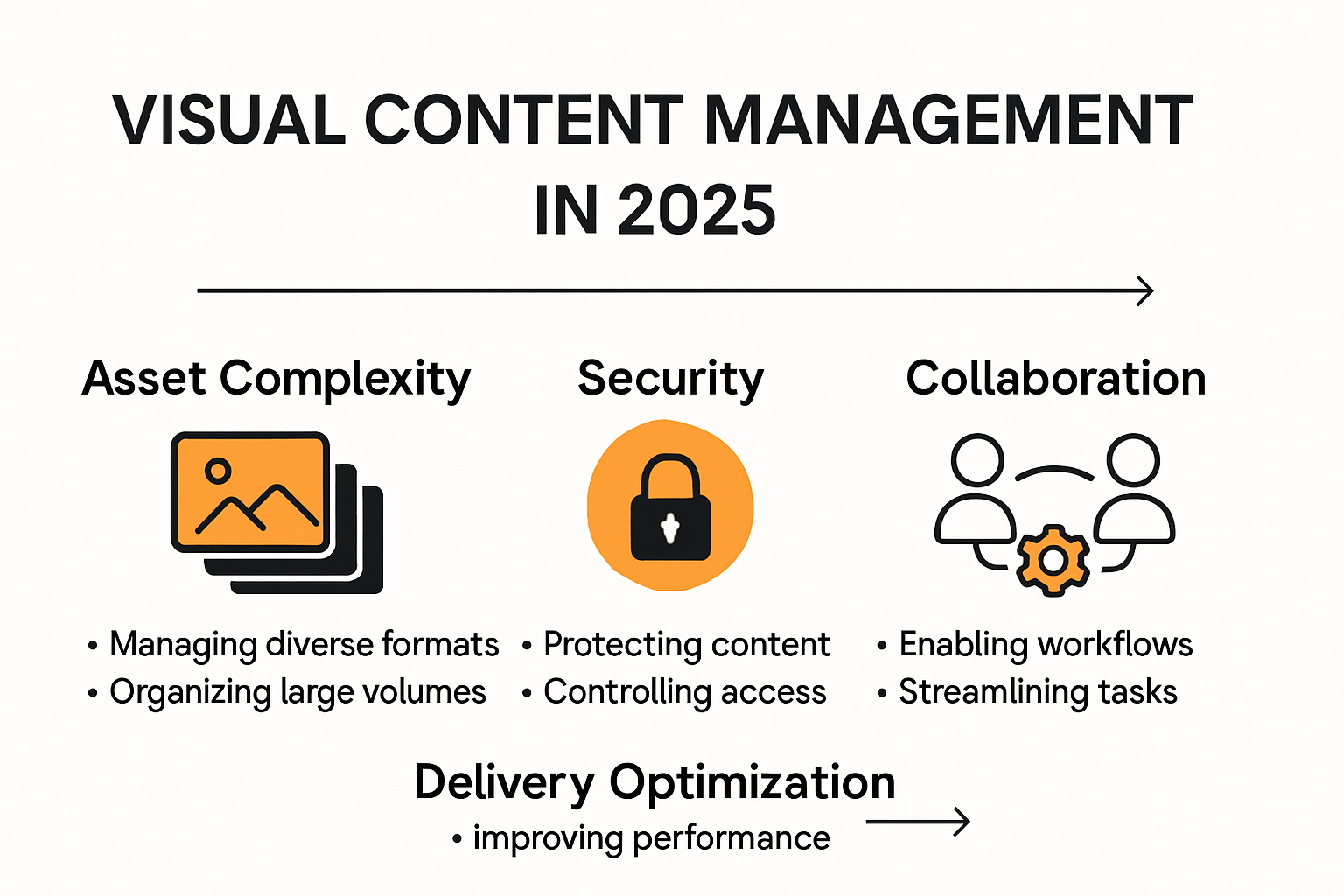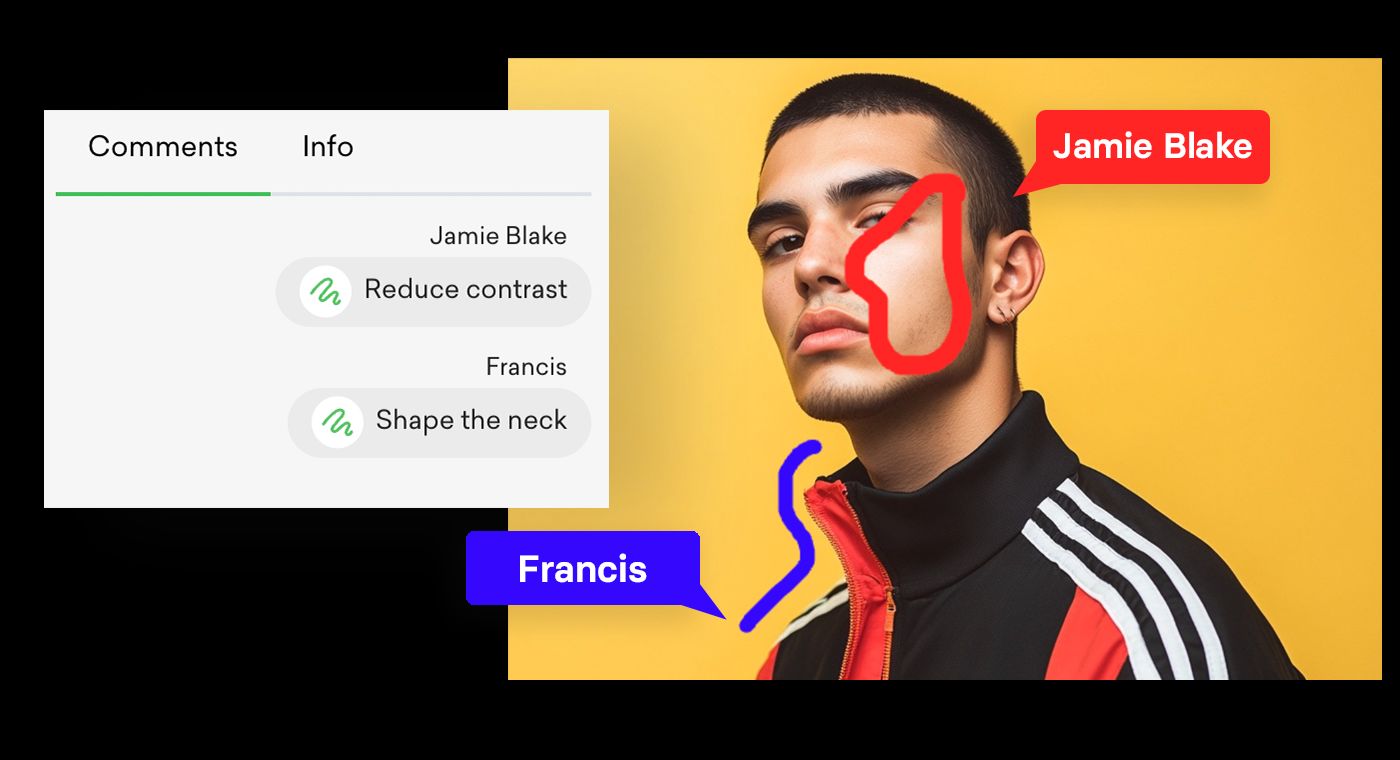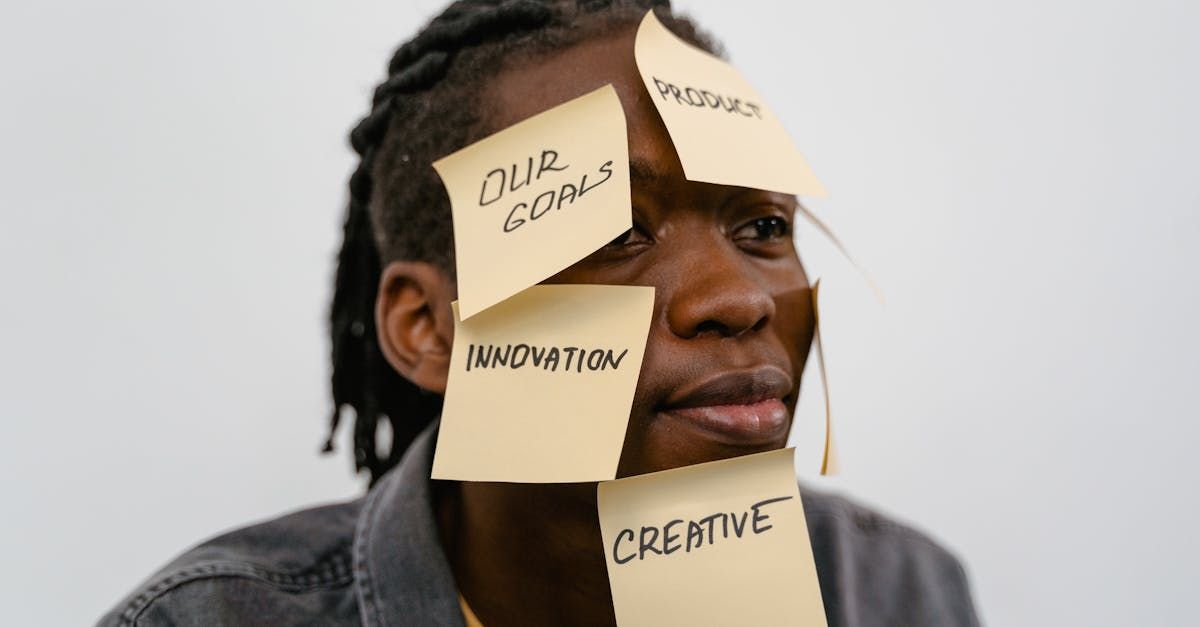Managing photos and videos is getting out of hand. Creative teams now handle thousands of high-resolution files for every project and the old ways of organizing them just do not work anymore. Most people assume the biggest hurdle is finding a bigger hard drive or faster cloud storage. Turns out, the real challenge is keeping everything secure, searchable and ready for instant teamwork. The smartest companies are ditching basic folders and jumping to AI-driven tools that rethink what visual content management really means.
Table of Contents
- Key Challenges In Visual Content Management
- Best Tools For Efficient Visual Content Workflow
- Proven Strategies For Creative Collaboration
- Optimizing Visual Asset Organization And Delivery
Quick Summary
| Takeaway | Explanation |
|---|---|
| Asset Complexity Requires Advanced Tools | The exponential growth and diversity of digital assets necessitate the use of AI-driven organization and management tools that can categorize and tag content efficiently while handling various file types. |
| Emphasize Security and Compliance | Effective visual content management must address security and privacy concerns by implementing robust access controls, encryption, and adherence to data protection regulations. |
| Facilitate Real-Time Collaboration | Creative professionals should utilize collaborative visualization platforms that enable real-time communication and collective asset review to enhance creative workflows. |
| Optimize Delivery with Advanced Mechanisms | Leveraging AI and modern CDN technologies can significantly improve the performance of visual content delivery, ensuring quicker access and efficient resource management. |
| Align Content Strategy for Success | Establishing a unified content strategy that aligns with business objectives and brand identity is crucial for fostering effective creative collaboration and achieving consistent visual narratives. |
 |
Key Challenges in Visual Content Management

Photographers, videographers, and creative professionals face an increasingly complex digital ecosystem that demands sophisticated visual content management strategies. As digital assets proliferate at an unprecedented rate, understanding and addressing key challenges becomes critical for maintaining workflow efficiency and protecting valuable creative work.
Asset Volume and Complexity
The exponential growth of digital assets presents significant organizational hurdles. According to research from Hivo, managing metadata and tagging for a vast number of assets is time-consuming and prone to errors. Creative professionals now generate thousands of high-resolution images and video files across multiple projects, making traditional file organization methods obsolete.
Unique challenges emerge from this asset complexity:
- File Diversity: RAW files, edited JPEGs, video clips, and vector graphics require different storage and management approaches.
- Version Control: Tracking multiple iterations of visual content becomes increasingly difficult without robust systems.
- Metadata Management: Accurate tagging and categorization demand significant manual effort and precision.
Security and Privacy Concerns
Visual content inherently contains sensitive information that requires careful protection. Research from arXiv highlights the critical need for comprehensive security measures when managing digital assets. Images and videos can inadvertently reveal confidential details about projects, clients, or creative processes.
Key security challenges include:
- Access Control: Limiting visual content visibility to authorized personnel
- Encryption: Protecting files from unauthorized access or potential breaches
- Compliance: Adhering to industry standards and data protection regulations
Performance and Accessibility Limitations
Traditional file storage and sharing methods struggle to meet modern creative workflows. Email attachments, local hard drives, and generic cloud storage solutions fall short in providing the speed, collaboration features, and intuitive interfaces that professionals require.
Professionals encounter performance bottlenecks such as:
- Large File Transfers: Slow upload and download speeds for high-resolution content
- Collaboration Barriers: Limited real-time review and feedback mechanisms
- Cross Platform Compatibility: Inconsistent file rendering across different devices and software
Addressing these challenges requires innovative visual content management solutions that prioritize efficiency, security, and seamless collaboration. Creative teams need platforms that can automatically organize assets, provide robust security protocols, and facilitate smooth workflows across diverse project requirements.
To help clarify the three core challenges presented in this section, the following table summarizes the main hurdles and example solutions mentioned:
| Challenge Area | Main Issues | Example Solution |
|---|---|---|
| Asset Volume & Complexity | File diversity, version control, manual metadata management | AI-driven organization, automated tagging |
| Security & Privacy | Unauthorized access, confidential data exposure, compliance | Access control, encryption, adherence to regulations |
| Performance & Accessibility | Slow transfers, poor real-time collaboration, compatibility | Modern platforms with collaboration features, optimized delivery |
Best Tools for Efficient Visual Content Workflow
Creative professionals require advanced tools that transform complex visual content management into seamless, intuitive experiences. Modern workflows demand solutions that go beyond basic file storage, integrating intelligent features that enhance productivity and collaboration.
AI-Powered Asset Organization
Advanced visual content management now leverages artificial intelligence to revolutionize asset handling. Research from arXiv highlights emerging frameworks like BlobCtrl, which enable precise manipulation and organization of visual content through intelligent blob-based representations. These tools automatically categorize, tag, and structure digital assets with unprecedented accuracy.
Key capabilities of AI-driven organization include:
- Automatic Metadata Generation: Machine learning algorithms that create comprehensive and accurate file descriptions
- Smart Tagging: Intelligent systems that recognize and classify visual content without manual intervention
- Predictive Sorting: Algorithms that anticipate user preferences and recommend optimal file arrangements
Collaborative Visualization Platforms
Modern visual content workflows require platforms that support real-time collaboration and interactive content exploration. ResearchFlow AI demonstrates how advanced tools can transform complex visual information into structured, accessible knowledge maps. These platforms enable seamless sharing, annotation, and collective review of visual assets.
Essential collaborative features include:
- Interactive Annotations: Real-time commenting and markup capabilities
- Permission-Based Access: Granular control over content visibility and editing rights
- Cross Platform Synchronization: Consistent experience across multiple devices and professional environments
Advanced Content Analysis Tools
Cutting-edge visual content management now incorporates sophisticated analysis capabilities. VizCV research showcases how AI-assisted visualization tools can transform complex datasets into comprehensible visual narratives. These tools provide deep insights into content characteristics, helping professionals make data-driven decisions about their visual assets.
Advanced analysis capabilities include:
- Automated Quality Assessment: Detecting image resolution, color consistency, and technical attributes
- Trend Recognition: Identifying patterns and similarities across large visual asset collections
- Semantic Content Mapping: Understanding contextual relationships between different visual elements
By integrating these sophisticated tools, creative professionals can transcend traditional file management limitations. The future of visual content workflow lies in intelligent, adaptive systems that understand and anticipate user needs, transforming complex digital asset management into a smooth, intuitive experience.
To assist readers in comparing the top features of each tool type mentioned, the following table highlights and contrasts their key benefits:
| Tool Type | Main Features | Example Benefit |
|---|---|---|
| AI-Powered Asset Organization | Auto metadata, smart tagging, predictive sorting | Faster, more accurate organization |
| Collaborative Visualization | Real-time annotation, permissions, cross-platform sync | Easier team feedback and sharing |
| Advanced Content Analysis | Quality assessment, trend recognition, semantic mapping | Better insights for data-driven decisions |
Proven Strategies for Creative Collaboration
Successful creative collaboration demands more than just talented individuals working together. It requires strategic approaches that foster communication, align creative vision, and create environments where innovative ideas can flourish and transform into exceptional visual content.
Structured Collaborative Frameworks
Digital Learning Edge highlights the critical importance of implementing robust collaborative design tools that enable real-time visual brainstorming. These platforms transform traditional workflows by supporting diverse creative processes and encouraging collective ownership of creative outputs.
Effective collaborative frameworks incorporate:
- Clear Communication Channels: Establishing transparent methods for sharing ideas and feedback
- Role Definition: Clarifying individual responsibilities within team projects
- Iterative Feedback Mechanisms: Creating structured processes for continuous improvement
Content Strategy Alignment
According to Yellowbrick, establishing a content strategy that aligns with business objectives and reflects the brand’s identity is fundamental for successful creative collaboration. This approach ensures that all team members work toward consistent, meaningful visual narratives.
Key strategic elements include:
- Shared Creative Vision: Developing a unified understanding of project goals
- Brand Consistency: Maintaining visual and messaging coherence across all content
- Performance Metrics: Defining clear benchmarks for creative success
Digital Collaboration Tools and Workflow Management
Modern creative teams rely on sophisticated digital platforms that facilitate seamless collaboration. Research from collaboration experts demonstrates that integrated tools can dramatically enhance team productivity and creative output.
Critical workflow management strategies involve:
- Content Calendar Development: Planning and organizing content creation efforts to maintain consistent production
- Version Control Systems: Tracking changes and maintaining comprehensive project histories
- Real Time Collaboration Platforms: Enabling simultaneous editing and immediate feedback
By implementing these proven strategies, creative professionals can transform individual talents into powerful collective capabilities. The future of visual content management lies not just in technological tools, but in creating adaptive, collaborative ecosystems that inspire creativity and drive innovation.
Optimizing Visual Asset Organization and Delivery
Effective visual asset management goes beyond simple storage and requires sophisticated strategies that ensure quick retrieval, seamless accessibility, and intelligent organization. Creative professionals need robust systems that transform digital asset management from a mundane task into a strategic advantage.
AI-Enhanced Digital Asset Management
ImageShop research reveals groundbreaking advancements in artificial intelligence integration for digital asset management. AI technologies are revolutionizing how visual assets are categorized, tagged, and processed, dramatically reducing manual organizational efforts.
Key AI-driven organizational capabilities include:
- Automated Metadata Generation: Machine learning algorithms creating comprehensive image descriptions
- Intelligent Tagging: Automatic recognition and classification of visual content
- Context-Based Searching: Advanced semantic search capabilities that understand visual relationships
Advanced Content Delivery Mechanisms
Research from arXiv demonstrates the evolution of Content Delivery Networks (CDNs) through cutting-edge technologies. Modern delivery strategies incorporate edge computing, hybrid architectures, and multi-CDN approaches to optimize visual content transmission.
Critical content delivery innovations include:
- Reduced Latency: Implementing HTTP/3 and QUIC protocols for faster content access
- Scalable Infrastructure: Distributed network architectures that adapt to varying content demands
- AI-Driven Traffic Management: Intelligent routing of visual assets for optimal performance
Intelligent Migration and Optimization Strategies
Advanced vehicular edge computing research highlights breakthrough approaches in content migration. Deep reinforcement learning techniques have demonstrated remarkable improvements in content delivery efficiency, reducing access delays by up to 70% compared to traditional methods.
Strategic optimization approaches encompass:
- Dynamic Content Routing: Adaptive algorithms that predict and optimize content delivery paths
- Predictive Caching: Anticipating user needs and preemptively storing frequently accessed assets
- Bandwidth Optimization: Intelligent compression and transmission techniques
These sophisticated strategies transform visual asset management from a technical challenge into a strategic advantage. By leveraging AI, advanced delivery networks, and intelligent migration techniques, creative professionals can ensure their visual content is not just stored, but strategically organized, quickly accessible, and efficiently delivered across diverse platforms and environments.
Frequently Asked Questions
What are the main challenges in visual content management?
The main challenges include asset volume and complexity, security and privacy concerns, and performance and accessibility limitations. Managing diverse file types, ensuring security measures, and dealing with slow transfer speeds can hinder effective visual content workflows.
How can AI improve visual content management?
AI enhances visual content management by automating metadata generation, smart tagging, and predictive sorting. These features allow for efficient organization and categorization of digital assets, reducing manual efforts and errors.
What tools are essential for collaborative creative work in visual content management?
Essential tools include collaborative visualization platforms that facilitate real-time communication, interactive annotations, and cross-platform synchronization to enhance teamwork and streamline workflows.
What strategies can optimize the organization and delivery of visual assets?
Strategies to optimize organization and delivery include implementing AI-enhanced digital asset management, utilizing advanced content delivery mechanisms like CDNs, and applying intelligent migration strategies to ensure quick access and efficient management of visual content.
Transform Content Chaos Into Creative Flow With Pikd
Are you tired of drowning in endless folders, slow file transfers, and scattered team feedback? The article highlights just how overwhelming it is for photographers and creative teams to manage complex digital assets. Between asset overload, version headaches, and unreliable client communication, creative momentum can grind to a halt. Now imagine replacing all those outdated tools with a single platform that streamlines everything from secure uploads to real-time collaboration and gallery delivery.

Experience what AI-driven organization, customizable permissions, and instant feedback truly mean when you use Pikd. Take back control of your visual workflow and show your clients your work exactly as you intended. It is time to simplify content management and turn your creative process into your biggest strength. Head to the Pikd website and see how you can organize, collaborate, and deliver your visual content confidently today.

































